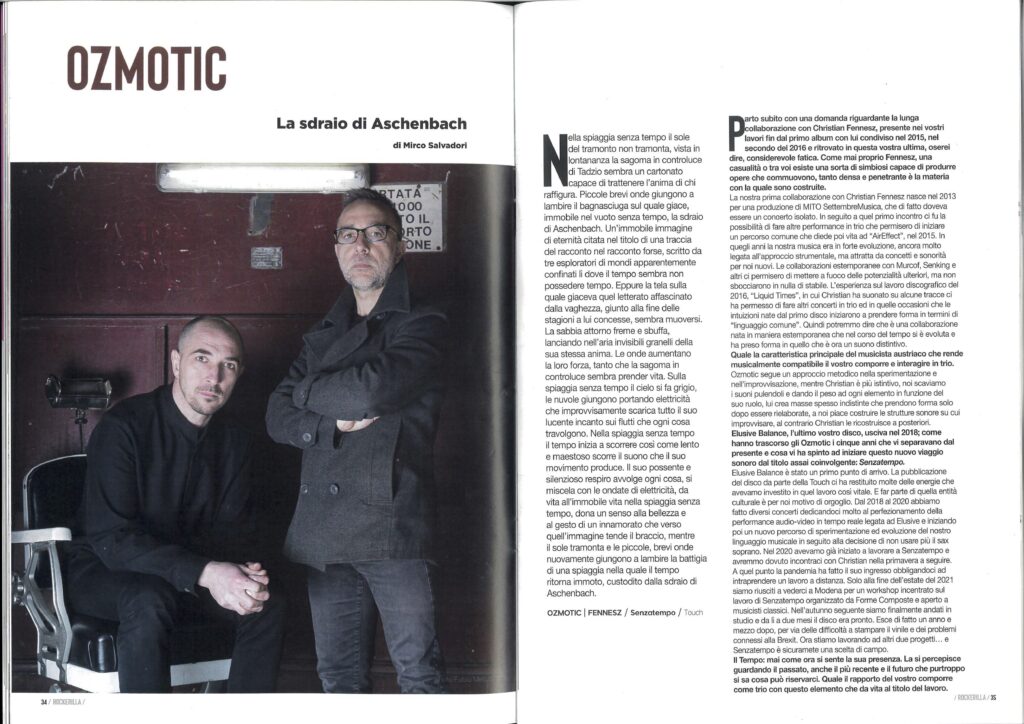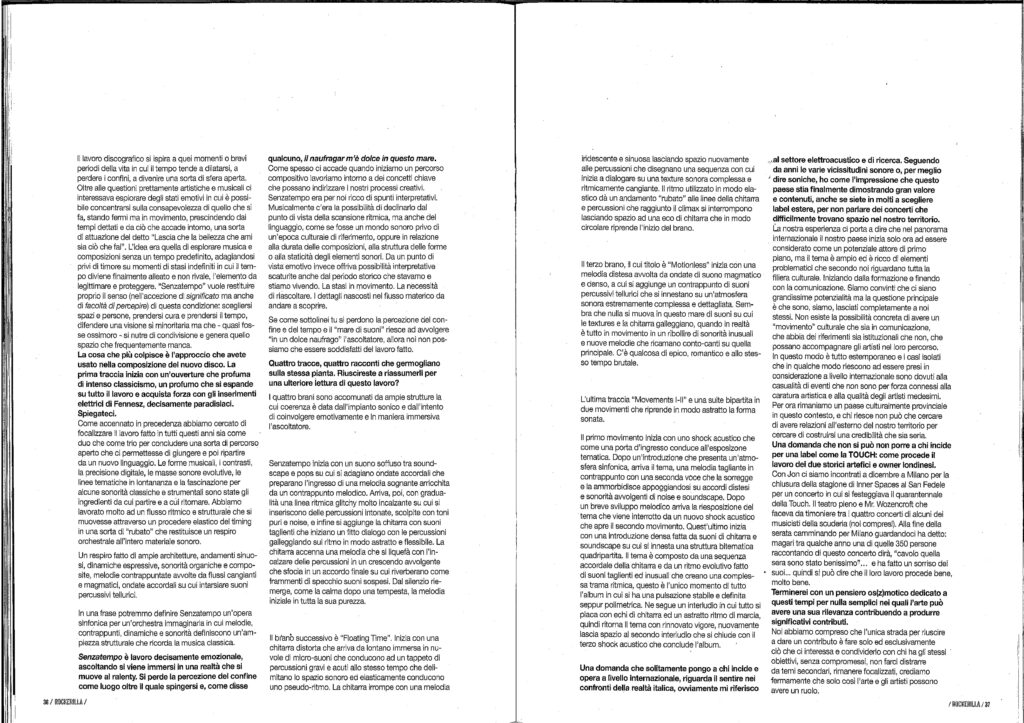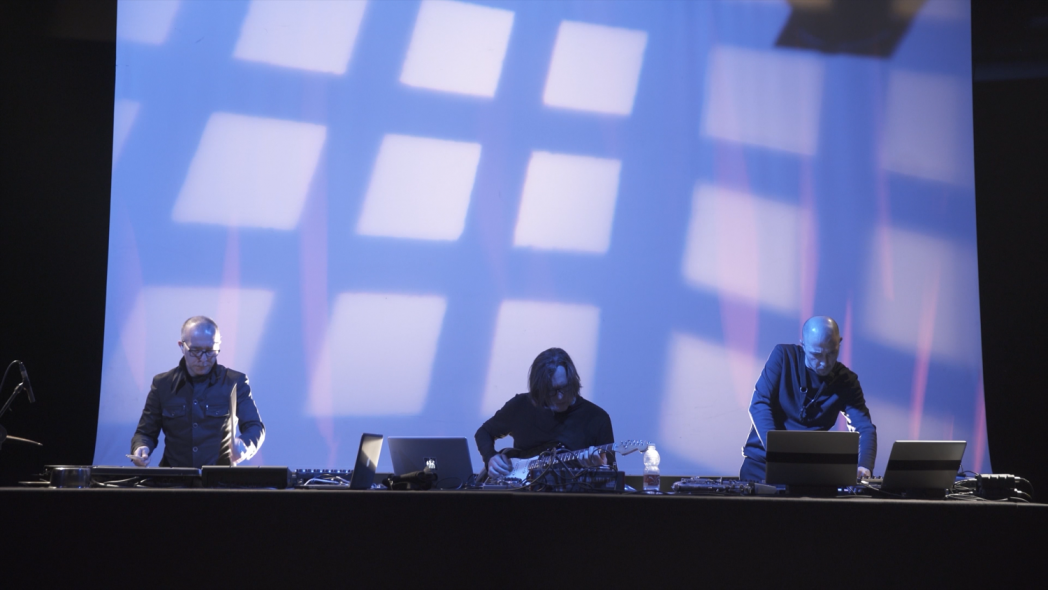-MX-4071_20230428_101924 MX-4071_20230428_102006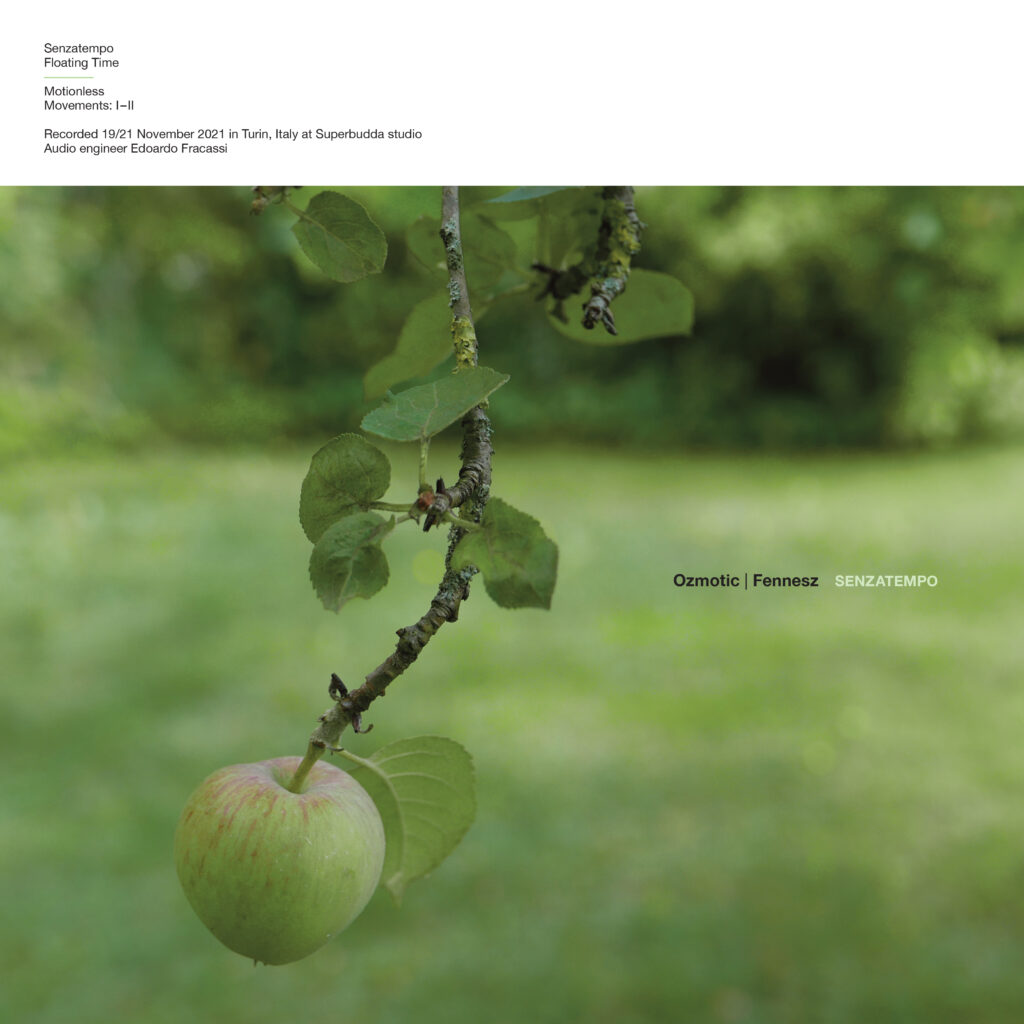
LP + DL – 4 tracks
Release date: Friday 14th April 2023 – you can pre-order your copy here
Track listing:
1. Senzatempo
2. Floating Time
3. Motionless
4. Movements l – ll
Recorded 19/21 November 2021 in Turin, Italy at Superbudda studio
Audio engineer: Edoardo Fracassi
Cut by Jason @ Transition
Photography + design: Jon Wozencroft
Senzatempo became a lockdown record. In 2019, a year after our last concert as a trio with Christian Fennesz, the release of his Agora and our first publication for Touch – Elusive Balance – we met in Milan. We talked about ongoing projects, the evolution of our musical language and, as is often the case when we are all three together, the more frenetic and superficial aspects of contemporary society, the difficulty of letting ideas and projects mature and how music could still play a constructive role in that context. We left each other with the intention of talking at a distance about a new project, to be developed calmly, without any hurry.
In the months that followed, after e-mails in which we continued to discuss the project, we decided to work on the perception of time and to focus our attention on those periods of life in which time tends to dilate, to lose its boundaries, dedicating ourselves to the project without the fear of resting on indefinite moments of stasis – trying to take the time of creation as an ally, making the most significant ideas ‘sprout’, distilling emotions and crystallising them slowly.
Catapulted into the first wave of the pandemic, we began to work at a distance, We exchanged different types of sound materials, sometimes raw, sometimes more structured and with Christian we tried to give musical form to a surreal calm, at the same time as magmatic, uncertain emotional states. In this phase of collective confusion and almost total isolation, the first drafts of Senzatempo and ‘Movements I’ were born. In both tracks, we tried to structure chordal waves and melodies inlaid with counterpoints with broad architectures and sinuous movements, in a sort of ‘rubato’, with the idea of creating an orchestral breath to the entire album.
Senzatempo is characterised by a dream melody with a dense and continuous dialogue between a sharp guitar and percussive sounds floating on an abstract and flexible pulse. ‘Movements I’, later transformed into a two-part suite, is airy and meditative; an initial acoustic shock leads to a melody resting on relaxed chords and enveloping sounds studded with noise, glitches and fragments of field recordings.
After this initial work, we wanted to organise a studio session, but pandemic restrictions forced us to postpone and leave the music to mature further. The following summer, thanks to a residency project for young artists centred on the Senzatempo project and conducted by Christian and ourselves in central Italy, the opportunity arose for the first time to play the material produced thus far, and to experiment and focus on new musical ideas.
In November 2021, after a concert we did in Turin, we finally devoted ourselves to the drafting of the album in a studio session lasting some days. The final versions of the first two tracks were created, with the addition of a second part to ‘Movements I’, and ‘Floating Times’ and ‘Motionless Image of Eternity’ came into being.
In ‘Floating Time’, clouds of micro-sounds envelop an iridescent, sinuous melody in a sonic space delimited by sculpted percussive sounds. Lost memories seem to resurface. The end of the track takes up the beginning in a kind of ‘rondo’. ‘Motionless’ is counterpointed by telluric percussive sounds in a complex and detailed atmosphere. It seems as if nothing is moving in this sea of sound on which the guitar floats, when in fact everything is in motion in a simmer of textures and melodies that embroider counter-songs to the main refrain.
The music of Senzatempo moves in balance between composition and improvisation. It is a symphonic work for an imaginary orchestra in which melodies, counterpoints, dynamics and sonorities define a structural breadth reminiscent of classical music.
Reviews:
Headphone Commute (UK):
…an expansive sonic architecture, balancing exquisite composition with space for improvisation…You can read the full review here
a closer listen (UK):
One day soon we may hear the last of the albums produced during the pandemic, but not yet. In the physical sense, this period was responsible for a blossoming of music; in the psychological sense, it highlighted the experience of time distortion, which was then translated into music. Drone seems the perfect genre for such perceptions, incorporating long, slow passages with undulating curves and incremental changes in timbre. Over time, the listener realises that movement has taken place, although it is often unnoticed while unfurling.
Enter Ozmotic and Fennesz, who exchanged files while isolated and were able to meet in person once the crisis eased to put the finishing touches on this album. The extension of time allowed the ideas to germinate, the notes to marinate into tones. A profound sadness seeps into the title piece, as orchestral tones gather and dissipate. High-pitched tones enter, heralding light percussion: time markers that distinguish this segment from others. The guitar joins the procession, tentative at first, then assertive; but never frantic, never rushed. Then a return to the beginning – but still something has changed: if not in the music, at least in the listener.
Floating Times seems a perfect title for the past three years. One year of the pandemic felt like two. Holiday and milestone celebrations were postponed. Days, months and finally years were dislodged. The track begins with soft static, blooming mid-piece into melody: a fragile heart still hoping to soar. An electronic pulse quickens with expectation, then fades, the static reemerging. For the second time, a track cycles back to the start, like samsara, providing hope of exit without an obvious path.
Is there a more drone-like title than ‘Motionless Image of Eternity?’ The title is tongue-in-cheek, since the track does move, and possesses both form and ending. The centre may seem nebulous, but a nebula also shifts – though such movements are imperceptible to the naked eye. The closing ‘Movements’ seems to counter the preceding title, although ‘movements’ has a double meaning. The track is composed as two movements, but the trio shares that it is also filled with “sinuous movements, in a sort of ‘rubato’, with the intention of creating an orchestral breath to the entire album.” Breath became a central theme of the pandemic, from those gasping for ventilator breath to George Floyd’s infamous “I can’t breathe.” While not directly referencing such associations, in a self-proclaimed ‘lockdown record’ they are difficult to escape. The fact that the closing tempo is the most obvious, the persuasion the most upfront, provides a sign of progress; society is again in motion, albeit wondering if it is moving in the right direction. [Richard Allen]
The Wire (UK):
Senzatempo is like meditating on the edge of an abyss. An overwhelming stillness, majestic and dangerous. [Leah Kardos] – the full review can be read here
Uncut (UK):
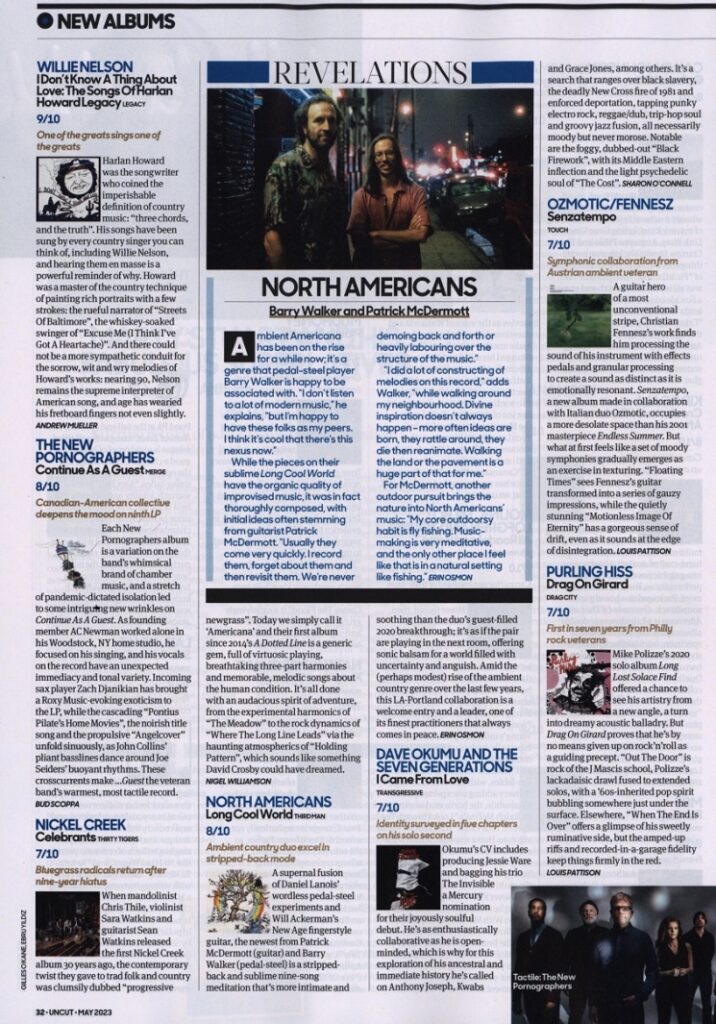
MOJO (UK):
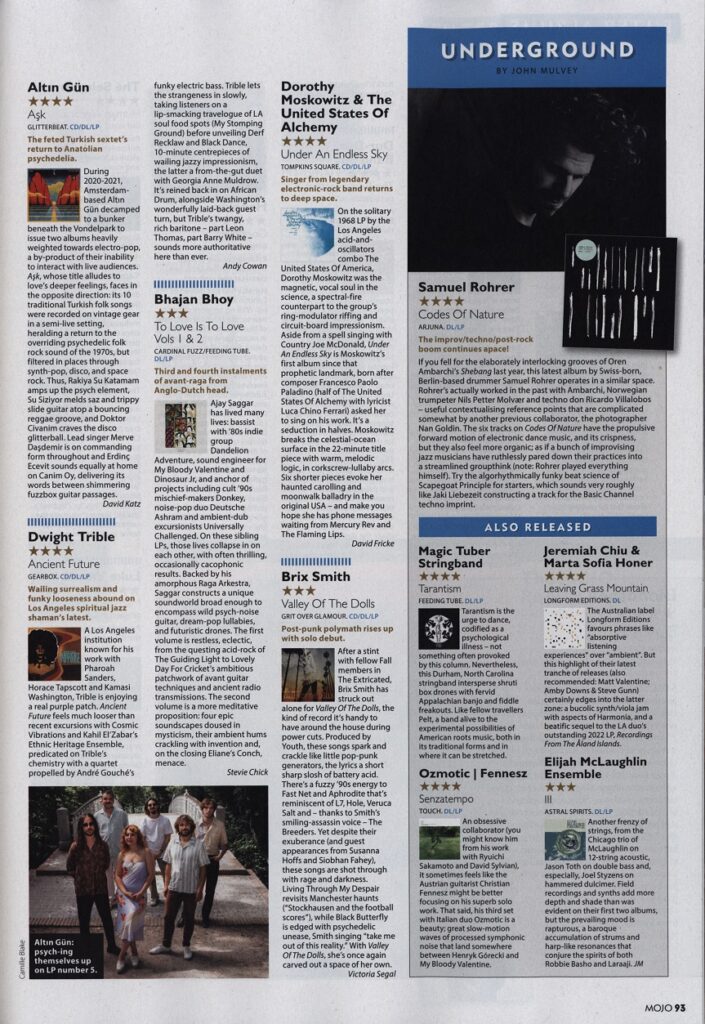
Juno (UK):
Not everyone will realise it, but Torino is one of Italy’s best-kept secrets and most fascinating cities. Even less will know that, for a brief period after the country we see today unified, its grand boulevards and statement palazzos made up the nation’s very first capital. A forgotten chapter that gave way to periods as an industrial powerhouse, economic centre of the Piedmont region, and then urban decay followed by population decline, with scars still very much visible in many areas. Not least those on the outskirts, where derelict spaces still offer a glimpse of what was, and everything that came before that.
A resident of the town, Ozmotic met with Christian Fennesz down the road (well, about two hours or so by train) in Milan ahead of setting to work on their latest collaborative project, S e n z a t e m p o. There, they apparently mused on philosophical ideas like evolution of musical language and the uneasy relationship deep dive artists such as them have with a world that wants to go faster, now, and stop for nobody. Nevertheless, the final album is every bit a product of the Torino studio in which it was recorded, in one long session which – by the sounds of it – must have got pretty intense.
Dark, futuristic ambient would be one way to describe what’s here. And that’s precisely the point. A city that lays claim to a highly experimental grass roots electronic scene (see: industrial noise maker Bienoise, albeit he’s technically based in the rural surrounds), these sonics invoke images of quiet desolation, post-human worlds, places filled with the ghosts of machines. Strange soundscapes that are at once unnerving and beautiful, the real question is whether the images it conjures are actually of tomorrow, or simply memories of yesterday. [MH]
Sun 13 (UK):
“…Shape-shifting elusively with sonic vignettes designed for late nights and dark rooms, alongside Fennesz’s distinctive guitar noodlings, Ozmotic pivot seamlessly in what matches up to the expectations many of us had when news of this collaboration surfaced…” You can read the full review here [Simon Kirk]
Salt Peanuts (SE):
Senzatempo (timeless in English) is the second collaboration of the Italian multidisciplinary, electronic duo OZmotic – soprano sax and electronics player Stanislao Lesnoj and drummer, objects and electronics player SmZ – with Austrian avant-guitarist and electronics player Christian Fennesz. This album is described by this ad-hoc trio as a partly composed, partly improvised symphonic work for an imaginary orchestra in which melodies, counterpoints, dynamics and sonorities define a structural breadth reminiscent of classical music. You can read the full review here [Eyal Hareuveni]
Ondarock (Italy):
You can read the full review here
Rockerilla (Italy):
lee-king (Japan):
www.ele-king.net/review/album/009180/
Electronic Sound (UK):
In one intensely productive session in Turin, Italian electronic wizards OZMOTIC and Austrian guitarist Christian Fennesz birthed the majority of Senzatempo. The opening title track sets the tone for the album – synths swell with majestic, restrained power, then Fennesz glides in, a shark fin piercing the waves, before the whole thing erupts into an overdriven, reverbed-to-hell beast. With distinct, yet utterly complementary sound
palettes, on the likes of ‘Floating Time’, OZMOTIC and Fennesz have forged unique soundscapes that are by turns graceful and epic. [AT]
Headphone Commute (UK):
Out of all of the negative and adverse comes something positive and desired – a record of expansive pseudo-orchestral movements wrapped in electronic microsound and glitch. The negative bit here is the onset of the pandemic, during which many of the musicians found themselves in isolation. And the positive, of course, is the newly found ways of collaborating together and creating something beautiful along the way. Such is the case for this ‘lockdown record’, where OZMOTIC and Fennesz found themselves to be a distance apart, exchanging ideas over a period of time that became this aural conversation on the perception of time. Working remotely on these ideas, the trio proceeded “to focus our attention on those periods of life in which time tends to dilate, to lose its boundaries, dedicating ourselves to the project without the fear of resting on indefinite moments of stasis – trying to take the time of creation as an ally, making the most significant ideas ‘sprout’, distilling emotions and crystallising them slowly.” Conceptually, that’s all fine and well, but what about the music? What has been bourne out of this effort, and what’s here to love?
The music of Senzatempo moves in balance between composition and improvisation. It is a symphonic work for an imaginary orchestra in which melodies, counterpoints, dynamics and sonorities define a structural breadth reminiscent of classical music.
This is not the first collaboration of this trio. In 2015, they released AirEffect on Folk Wisdom. A year later, Fennesz appeared on Ozmotic’s ‘Liquid Times’. Meanwhile, Fennesz last put out ‘Agorain 2019′ on Touch, which has subsequently won my praise as one of the best albums in ‘Music For Sonic Installations In The Cavern Of Your Skull,’ which he followed up with two live recordings, one ‘Live At The Jazz Cafe’ (Touch, 2019) and the other ‘Live At Empty Bottle,’ Chicago (2020, self-released). So yes, one can almost say that this is the first record from Fennesz in the last four years. This album came out on April 14th, and, unfortunately, as of this writing, the vinyl copies are already all sold out. But digital, of course, is still available, and arguably, it is just as good. I highly recommend this album, and I’m sure I’ll see it appearing on these pages again, celebrating the best music of this year.











